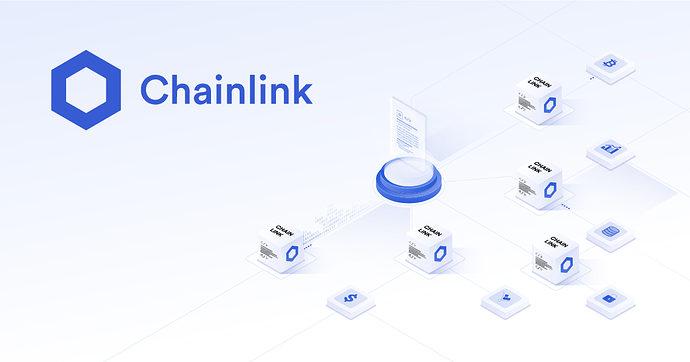What Is Chainlink?
Chainlink (LINK) is a cryptocurrency and technology platform that enables non-blockchain enterprises to securely connect with blockchain platforms. Chainlink is middleware that connects blockchain-based smart contracts with external data, such as baseball scores or stock prices.1 Chainlink’s LINK currency pays Chainlink network operators and collateralizes the network’s smart contract agreements.2
Chainlink is known as a decentralized oracle network or blockchain abstraction layer. Chainlink uses blockchain technology to securely enable computations on and off chain, supporting what it calls hybrid smart contracts.3 Enterprises using Chainlink can access any major blockchain network, including Ethereum and Solana.45
The Chainlink blockchain is hosted on the Ethereum platform, which uses the proof-of-stake operating protocol.6 In addition, Chainlink is an open-source blockchain project, meaning anyone can view the project’s code and contribute.7
KEY TAKEAWAYS
- Chainlink is a decentralized oracle network that connects blockchains with off-chain data.
- Chainlink uses hybrid smart contracts to integrate on-chain code and off-chain data infrastructure.
- Chainlink tokens—called LINK—serve as currency to pay Chainlink network operators for retrieving and preparing off-chain data and performing computations.
The Chainlink blockchain can support the secure sharing of inputs, outputs, and computations. Some features of Chainlink include:
- Supporting decentralized data feeds: Data from many sources can be securely collected and processed for hybrid smart contracts.
- Providing verifiable sources of randomness: Applications such as games that require cryptographically secured randomness can use Chainlink.
- Enabling automation: Chainlink smart contracts can automate critical functions and event-driven tasks for enterprises.
- Supporting cross-blockchain interoperability: Chainlink can connect blockchain platforms to support the exchange of messages, tokens, and specific actions.8
Understanding Chainlink
Chainlink is a blockchain-based decentralized oracle network that was launched in 2017.9 Oracles are entities that connect blockchains to external systems, thereby allowing smart contracts to execute based on inputs and outputs originating from the blockchain.10
Though traditional oracles are centralized, Chainlink decentralizes the process of moving data on and off blockchains through "hybrid smart contracts."10 LINK tokens are used to reward Chainlink network operators for retrieving data from off-chain feeds, formatting data into accessible formats, and performing off-chain computations.2
The Chainlink decentralized oracle network is a system of nodes that adhere to set protocols. Node operators are required to stake—lock a specific number of—their LINK tokens. Node operators set their own fees based on demand for the off-chain resource they provide.11
Chainlink node operators with the largest stakes are the best positioned to earn LINK rewards.12
Because Chainlink allows blockchains to exchange data with off-chain systems in a decentralized and tamper-resistant way, the Chainlink oracle network has many use cases. Chainlink has been used to fairly distribute non-fungible tokens (NFTs), gamify personal savings, and facilitate recalibrations of cryptocurrency token supplies, among other applications.13
Chainlink was created by Sergey Nazarov and Steve Ellis, who authored a 2017 white paper with Ari Juels.9 The network launched in 2019.14 LINK is an ERC-20 token, meaning that it is compatible with other currencies and smart contracts supported by the Ethereum platform.15
How Does Chainlink Differ From Ethereum?
The Chainlink network is, in some ways, a complement to the Ethereum network and other blockchains. Chainlink can facilitate secure communications between Ethereum projects and various off-chain data. Because Chainlink’s LINK token is built on the Ethereum platform, LINK is compliant with the Ethereum platform’s protocols.
Ethereum tokens can be used to spend on purchases, facilitate smart contracts, and pay miners for operating the Ethereum network.16 Chainlink tokens have only a single use case, which is to pay node operators in the Chainlink network.
The proof-of-stake mechanism rewards network participants for placing a freeze on the ETH they “stake” or put up as collateral for the chance to earn rewards.17
Goals of Chainlink
Chainlink aims to continue to grow by expanding its support for blockchain environments and facilitating new use cases for hybrid smart contracts. Because significant stores of data and records are not yet maintained within blockchains, Chainlink may have countless opportunities to connect blockchain networks with off-chain information.
In 2021, the Chainlink network secured more than $75 billion of value as it grew to include over 1,000 projects.18 Chainlink has a maximum supply of 1 billion tokens, of which about 491 million have been issued (as of September 2022).19
What Can I Buy With LINK?
LINK cryptocurrency is used to incentivize Chainlink node operators rather than being designed for everyday purchases. These network participants, tasked with securely transferring data to and from blockchains, are paid in LINK.
Why Is Chainlink Popular?
The Chainlink decentralized oracle can connect many types of data with various blockchains, creating many potential applications for Chainlink. Chainlink could help to integrate blockchain technology with many industries and business functions.
Is Chainlink Made by Oracle?
Oracle Corp. (ORCL) is a computer technology company specializing in database management. Chainlink is not affiliated with Oracle Corp. Chainlink refers to itself as a decentralized oracle network, with the “oracle” being a broad-based group of intermediaries that connect blockchains with off-chain information systems.20
